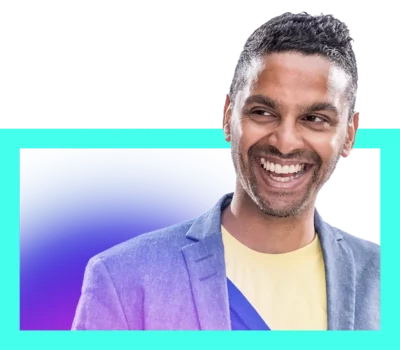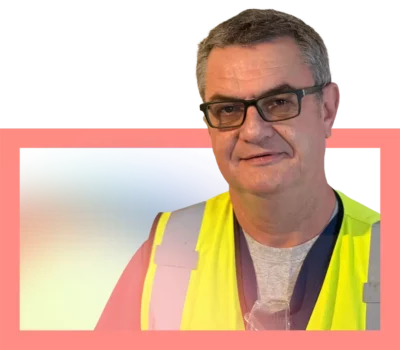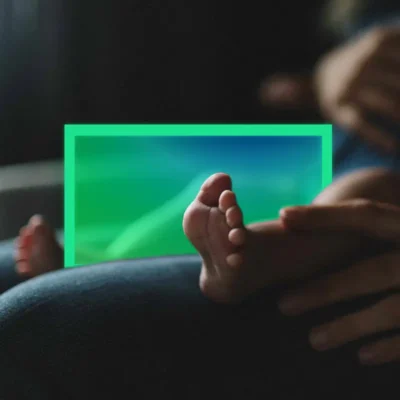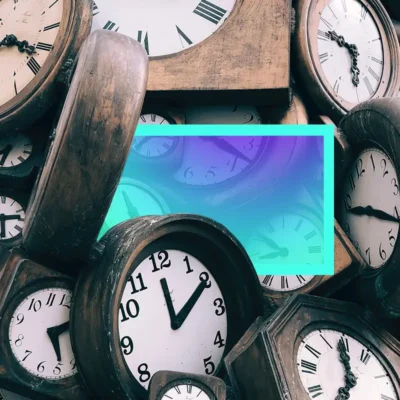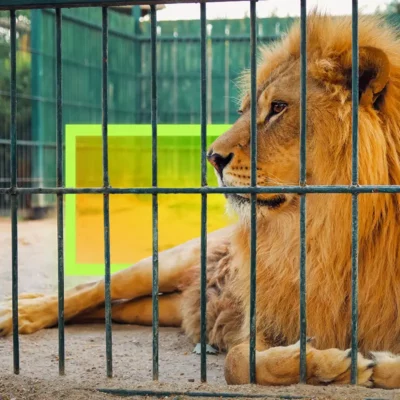A nurse’s story

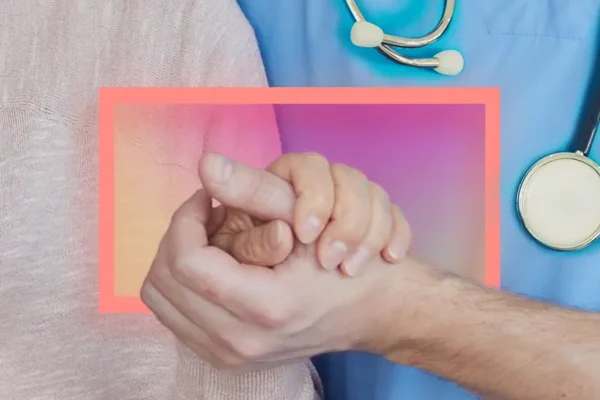
Table of Contents:
Transcript:
A nurse’s story
WAYNE LITTLE: On Sunday, I am out here and walking down the line of waiting cars, and I see a particular pod of nurses who have all become friends and all work together, in part because they all like to sing. It is great to watch people driving through react to it. People tell us that they’re looking forward to their second dose, because it’s kind of fun just to actually be here.
It amazes me, but the nurses actually like to dance up and down the line. Even working in the rain, you can see the joy on their faces. We have very few absences. The workforce out here has become exceptionally tight.
This is the first nursing job they’ve ever had, and I can see many of them love it, just like I did, from the very first day.
ROHAN GUNATILLAKE: Many of us have heard the stories of very real challenges healthcare workers have had to face this last year; you may even be one yourself. But for Wayne Little, the pandemic reaffirmed his devotion to nursing and brought some of the most profound and the most joyful moments of his professional life. As a top nursing administrator at UC San Francisco, Wayne is a lead at the mass COVID vaccination site at the City College of San Francisco where they’ve administered over 100,000 doses to date.
In this episode of Meditative Story, Wayne shares an intimate reflection on his calling to be a nurse and what he will take with him from the biggest mobilization of nurses the world has ever seen.
In this series, we combine immersive first-person stories and breathtaking music with the science-backed benefits of mindfulness practice. From WaitWhat, this is Meditative Story. I’m Rohan, and I’ll be your guide.
The body relaxed. The body breathing. Your senses open. Your mind open. Meeting the world.
LITTLE: At the end of nursing school, I think, maybe this isn’t for me. I am not much of a student, and it seems like too many rules and regulations. But my roommate convinces me to apply for a job along with her at a large hospital system near where I grew up in New Zealand. I’m 25 years old when I walk into the clean, brightly lit institution. I recognize many friends from school. I meet a charge nurse named Robin Steed, and she enters the room with presence. Soon I am spellbound by her, her utter confidence, her strong voice, even her clean white uniform. She conveys the sense of being in the absolute right body, in the right place, and in the right career. She talks about a profession driven by scientific knowledge, this large sea of trained people all working toward one goal: superior care for patients. There’s a mission behind all that training.
From day one, I am swept up with the job. It is the first time in my life that I love getting up and going to work. It’s not about just standing at the bedside. It’s about being there for real people, up close and being in the moment.
Perhaps I was primed to believe that patients matter. When I am 14, my mother is diagnosed with cancer. We live in a small town of about 900 people, and my dad works a few hours’ drive away, so everybody pitches in. My grandmother, who lives about a mile away, walks to our place every morning to make sure me and my four siblings all get off to school.
Sometimes it is left to me to drive Mum to the hospital an hour away. I am too young for a driver’s license, but the only police officer in town looks the other way as I peer out behind the enormous steering wheel of our Hillman Super Minx. It’s a boxy 1960s car, stick shift, mint green. Sometimes it makes terrible noises, because I am not very good at shifting. I take the curves slowly as Mum lies in the backseat, unwell. But she keeps the conversation going. I love driving her, because we talk like we’ve never talked before.
I have a growth spurt, which makes the driving easier. But she gets sicker.
I am more of an animal person than a sports kid. My elder brother is great at contact sports, but my sister and I feed the goats and the working dogs. We have these calves named Coey and Joey. Every morning we make formula and feed them before going to school. When it comes time to show them off at Calf Club Day, we furiously bathe and scrub them. Then we parade around the ring. We don’t win anything, but we are so proud of those calves and how we have fattened them up.
After school, I do the laundry. With seven of us, there is a lot of laundry. When I’m 16, Mum doesn’t get dressed in street clothes any more. After I wash her nightclothes, I turn them inside out and iron them. I don’t think anyone has asked me to do this. I just want to make her more comfortable.
At home for the last three weeks of her life, her friends and family bustle all around her, and I watch nurses coming over to give her morphine and care for her. She doesn’t want us kids to see her die, so she dies sitting with a friend, the way she wants. She is just 37 years old.
Throughout that experience, the local doctor and nurses are integral to our family. In fact, after Mum dies, the doctor recommends me for my first job, which, at 16, is working as a bank teller, a pretty coveted job. On my first day, the local priest, who lives down the street, sends me a telegram. He could have just passed me a note, but he sends a telegram. In capital letters, it says: CONGRATULATIONS. And we are not even Catholic.
That’s what kind of community helps raise me. I will always remember the support and the faith people have in me, the pride I slowly build.
GUNATILLAKE: That’s a lot. Let’s breathe with Wayne as he takes a pause. Breathing in, the beauty of community, breathing out the sadness of loss. Breathing in the kindness of others. Breathing out.
LITTLE: In my second year of nursing, I work in a hematology ward. We have young patients with leukemia. Some of them have very long hospital stays, and we get to know them well. One young man, a farmhand, goes into remission and asks me to be his best man. I’m incredibly honored, but also torn about it, because it would mean adjusting the patient-nurse relationship. But his cancer comes back, and I know I can help him during the wedding by being a nurse as well as a friend. It’s a beautiful ceremony, and I feel privileged to be a part of it. I know he will die soon. Even though this work can be emotionally tough, I know I am making a difference to the patients and their families, and that keeps me in it.
I move to Australia and work both at the bedside and as a nursing instructor, which I enjoy. Then at a job fair, I see an opportunity to work in San Francisco, and I think, why not? What starts as an exciting change turns into a career transformation, because the University of California San Francisco takes nursing as seriously as Robin Steed did back on my very first day on the job. It wants to be the preeminent nursing program in the world. That’s what I want too, and I have some ideas about how to go about it.
When I have barely settled into a new executive position, everything changes. I could never have imagined how quickly I would be gaining insight into delivering healthcare under extraordinary conditions – a global pandemic.
Our job goes from assembling people who have an almost spiritual calling to serve others, to mobilizing them for a battle we didn’t seek and didn’t see coming. Yet the two threads – love and war – must go hand in hand if we are to be effective. We prepare in short order. When we don’t see a large patient caseload in San Francisco, we pivot to supporting the communities that need us with supplies and staffing. We put a call out for our nurses to deploy to New York City, and then to San Quentin state prison, and then to the Navajo Nation – and each time, we get this incredible response. The call to duty astounds me. It humbles me. It inspires me.
Working with Covid patients is unlike anything we’ve ever seen, not only in the care we deliver, but the way we deliver it. When someone is dying and they can’t have their loved ones with them, it’s a denial of our most human instincts, to be together at the end of life. And so we are no longer just caregivers – we also become their primary source of this fundamental connection. It’s an extraordinary role. You can’t walk away from it.
I’ve heard it said that the antidote to trauma is purpose, and now I know it’s true.
By January, we pivot again to providing vaccination on a mass scale. The world’s never seen this before either. After the heartbreak, loss, and fear that defined 2020, most people are desperate to get vaccinated. We know we have to move as fast as humanly possible. And we also want to honor the relief and hope of this act.
You’d think the nurses might be reluctant to do this job, too. It’s high-pressure, uncomfortable, high-paced. We partner with the City of San Francisco. We have 10 days to build a mass vaccination clinic. We design a 23-lane drive-thru, with 175 people working so we can deliver up to 650 shots an hour, 5,000 shots a day. To find enough staff, we turn to the brand-new nurses just out of school, and we know we have a small window not just to train them but to get them on board with our mission, just like Nurse Steed did for me 32 years ago.
If they can feel the purpose, they will succeed, and turn the pain of this year into something joyous.
We ask ourselves, “How could we make this an awesome patient experience?” and then we come back at it from the other way and we ask, “How do we make people fall in love with working here, so that they can make it an awesome patient experience?”
GUNATILLAKE: This is such an important flip. In meditation, I call it turning the camera around on itself. And we can do it ourselves anytime. Step 1, be aware of what is happening in our experience, in our mind and body. Step 2, notice if there is anything you are bringing to this moment, any filter, any assumption.
LITTLE: The site sits in the fog belt. The wind blows straight in off the ocean, and then it starts to rain. It is one of the most miserable places on earth. We start every morning with a huddle. People are wearing their down coats and their rain pants and their hoods are up. And we wear our bright bumblebee vests so people in the cars will know we are here for them.
We start by thanking our workers for coming. We go through what we’re doing today – 3,000 doses. And we say, “Hey by tonight, 3,000 people who are currently not vaccinated from this community will be, so thank you for that.” The team leaders introduce themselves so they know who we are if they need to warm up or take a break or work out their hand cramps from delivering the shots. I say, “My name is Wayne. I’m the clinical facilitator, and my job is to look after you.” We announce a couple of birthdays and lead everyone through a few goofy group stretches. By this point, we can feel the enthusiasm start to build. Every morning huddle ends the same way: Someone yells out, “What stops the dose?” And everyone yells out together, “Nothing stops the dose!”
On Sunday, I am out here and walking down the line of waiting cars, and I see a particular pod of nurses who have all become friends and all work together, in part because they all like to sing. It is great to watch people driving through react to it. People tell us that they’re looking forward to their second dose, because it’s kind of fun just to actually be here.
It amazes me, but the nurses actually like to dance up and down the line. Even working in the rain, you can see the joy on their faces. We have very few absences. The workforce out here has become exceptionally tight. This is the first nursing job they’ve ever had, and I can see many of them love it, just like I did, from the very first day.
One of the nurses, Serena, she has three kids. It’s taken her 10 years to get through nursing school and college. On her graduation day, she doesn’t want to leave the vaccination site to attend the ceremony. That’s how dedicated she is, that’s how much this means to all of us. So we all form two lines so we can give her an honor walk before work. She strides between nurses, who are cheering and clapping. She’s wearing her navy scrubs and her neon vest, her hand on her heart, her brown hair blowing in that San Francisco wind. She has a mask on, but you can tell she is tearing up, and so many of us are. It’s beautiful.
When the government announces that children over 12 can get the vaccine, the mood lifts even more. Now we have children in our midst. A van rolls in with a family of six kids, all the right age for the dose. I can’t believe it, all six kids fit into the new age eligibility. The parents are visibly excited. Our work today is a pathway for them to go back to the life they had with their kids prior to Covid. One by one, the kids stick their arms out of a window. They don’t have to wait too long, because our teams are so good.
Here’s what I see in our nurses, even at the end of a long day in the fog: a welcoming attitude, attention to detail, empowerment, warmth. It was unexpected, but it turns out that we have provided an environment where these qualities can be nurtured. They’re taking absolute pride in the role they perform. It helps that the patients are so grateful for this moment.
We are all part of this enormous collective endeavor. It’s public healthcare at its finest hour, in its purest incarnation. There is nothing between us and the delivery of care. We don’t collect insurance payments. We don’t do any sort of screening other than the age requirements. We have a particular workflow for undocumented people. Our aim is not to marginalize anybody. We offer lines and documents for different languages. This is an initiative without a border.
I don’t want to detract from the absolute tragedy that Covid was for the world, but working the vaccine site has been the best job I’ve ever had. It has changed my life and the way I think about care. It has given us so many opportunities to learn how to do what we do better.
As the cars and vans and trucks come and go across our 23 lanes, I’m challenged to think differently about what I call community. It’s not just our towns or our institutions, our families or the few memorable patients who told us we made a difference. I now view community in its broadest sense, a global sense. All I’m really doing is giving back what I have received. However we define it, we can all enrich our lives simply by caring. At the end of the day, we all have an opportunity to care for someone.
It’s great that it’s coming to an end, because it means we’ve got where we want to be. But on a personal level, I could do this for so much longer.
We have a unique opportunity to create something amazing, we are doing it, and we literally bask in it every day.
Rohan’s closing meditation
GUNATILLAKE: Like Wayne I too have been working on the covid vaccination program, but here in Scotland. And not on the front line, but on some of the technology that enables it. There is a lot to love across Wayne’s story but what is really speaking to me is the piece about that drive through center and how it is for everyone. No-one left out. No barriers.
So that is how we’ll meditate together for a short while.
Making the decision that there’s no need to give any more attention to anything else than what is happening right now.
Letting the body be however wants to. Noticing how you’ve naturally settled into a comfortable position. The body already knowing what it needs to do. Allowing yourself to smile a tiny smile.
Acknowledging that just this simple act of listening to our podcast, of doing this meditation, is an act of kindness to yourself. And letting the smile be a reflection of that.
Now, become aware of your whole body as it is, here. There’s no need to pay attention to any particular part. Instead, just letting your mind and your awareness spread out to fill the whole sense of the body.
Being aware of the whole body from the crown of your head to the tips of your toes – and everything in between.
We spend so much of our days stuck in our head. This is an opportunity to do the opposite and rest with the body. Letting your awareness fill the whole of the body.
With our awareness now a little bit established let’s invite the breath to the party. Taking as much time as you need to notice where in the body you can most feel the movements of the breath.
This is likely to be in the chest or in the belly as they move up and down. Take some time to feel the breath. Wherever it is.
And if you’re not quite able to connect with it just like that, try putting your hand on your belly or chest as a way to get a better sense of the rhythmic movement.
Now that you’ve found the breath, let’s connect with like we did before. This is where the magic happens. What we do is invite the breath into the whole of the body.
Instead of feeling the movements of breathing in one particular place, making the decision to feel them in the whole of the body.
From the top of your head to the tips of your toes. Feeling the breath everywhere. Letting the breath be everywhere. Marrying the feeling of the breath with that of the whole body.
All the body included. All the body welcome.
Taking your time. There’s no rush.
The whole body breathing in. The whole body breathing out. The whole body breathing.
Keeping a very quiet smile if that helps. Enjoying the sensations of the technique. Letting the breath be however it needs to be.
Whole. Body. Breathing.
And with this foundation, also allowing the rest of experience in.
Touch. Sound. Sight. Smell and taste. Mind, mood, thoughts.
Nothing left out. All included. All welcome. Awareness with no barriers.
And if there is joy here, leaning into that joy. If there is appreciation, enjoying that. It doesn’t matter. Because we’re letting everything in. And loving it whatever it is.
Distraction shows up, loving that too. Confusion? Come on in. Come get some.
No barriers. 23 lines of input. Experience showing up. Awareness of experience showing up at the same time.
Thank you, Wayne. So many thank yous.
And thank you. Go well.
